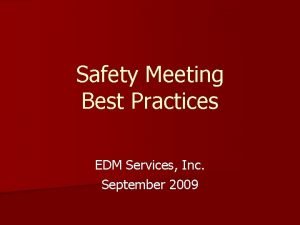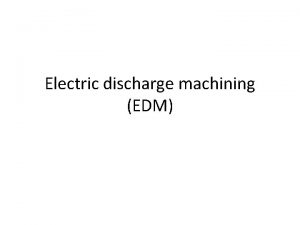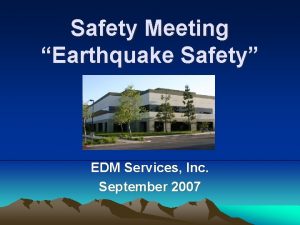Safety Meeting Railroad Safety EDM Services Inc July





- Slides: 5

Safety Meeting Railroad Safety EDM Services, Inc. July 2009

Steps to Safety – Facts & Tips n n n Freight trains do not travel on a predictable schedule & schedules for passenger trains change. Train tracks are private property and trains have the right of way 100% of the time. If there are rails on the railroad ties, assume that the track is in use, even if there are weeds or the track is “rusty”. A typical locomotive weights approximately 400, 000 pounds or 200 tons. The weight ratio of an automobile to a train is proportional to a soda can and an automobile. A train may extend three feet or more outside the steel rail which makes the safety zone for pedestrians much wider. Trains cannot stop quickly. A 100 car freight train traveling at 55 mph will need more than a mile to stop. There approximately 140, 000 miles of railroad tracks in the US. Trains can move in either direction at any time. Trains are sometimes pushed rather than pulled by a locomotive. Modern trains are quieter than ever with no telltale “clickety-clack” sounds. An approaching train is always closer and moving faster than you think. Cross tracks only at designated pedestrian or roadway crossings. Observe and obey all warning signs and signals. Never walk down a train track, it’s illegal and dangerous. By the time an engineer can see a pedestrian or vehicle on the tracks it’s too late.

Statistics n n n Every 2 hours a person or vehicle is hit by a train in the U. S. There were 286 highway-rail grade crossing fatalities and 986 injuries in 2008, 24 of the fatalities were in California. 50% of all crashes occur within 5 miles of the victims home. 2, 391 crossing collisions occurred in 2008, 140 were in California. Highest number was in Texas at 228. In 1972 there were 12, 000 collisions between trains and motor vehicles annually, that has been reduced by 80% to 2, 391. The primary causes of train crashes that resulted in deaths or injuries: Human Factors, causing 38. 2% of railroad accidents; Track Defects, causing 34. 94% of railroad accidents; Miscellaneous Causes, causing 12. 81% of railroad accidents; Equipment Defects, causing 12. 27% of railroad accidents; Signal Defects, causing 1. 76% of railroad accidents.

ARB employee working on a Chevron project at the Pittsburg Junction Antioch man dies after truck, train collide in Bay Point By Roman Gokhman Contra Costa Times Posted: 07/14/2009 04: 53: 02 PM PDT Updated: 07/15/2009 03: 12: 36 PM PDT BAY POINT — An Antioch man driving a pickup truck died from his injuries Tuesday evening, just hours after an Amtrak train struck the truck at a private crossing, authorities said. The truck driver, identified as Juan Tejada, 45, died in the hospital to which he was transported by helicopter A Contra Costa firefighter surveys after the crash, the Contra Costa County Coroner's Division said. The the scene where a truck was hit by 3: 55 p. m. collision scattered pieces of the truck more than 100 feet along an Amtrack train… BNSF Railway tracks, about 100 yards west of North Broadway Avenue in Bay Point, authorities said. The westbound No. 713 Amtrak train — traveling between Bakersfield and Oakland — had 129 passengers onboard, Amtrak spokeswoman Vernae Graham said. No passengers or crew members were hurt, Graham said. BNSF is investigating the collision, company spokeswoman Lena Kent said. The truck had been following another vehicle that cleared the private crossing, which had a stop sign but no crossing guards, Kent said. It was not clear if the two vehicles had been traveling together, she said. The pickup, possibly a Ford F-550, had been towing a large compressor, Kent said. It was unclear how fast the train was traveling when the crash occurred, but the passenger train speed limit in the area is 79 mph, officials said.

Safety on Board On Board the Train n n n Always hold the handrail when climbing or descending the stairs on board the train. Always store your belongings under your seat or on your lap, not in the aisles. Always collect your belongings and move toward the exit as soon as your station stop is announced. Train stops are brief; be ready to exit immediately. Always secure bicycles with the straps located across from the restrooms on each car. Only two bicycles may be stored at each location. Never lean on the doors or hold them open. Use seat backs and handrails while walking through the train. Watch your step moving from car to car while the train is in motion, as the vestibules can be slippery. Be sure to step over the gap between the train and platform. Leave personal food items and baggage at your seat. Wear shoes at all times and use caution when wearing shoes without rubber soles. Never attempt to board or exit a moving train. Make sure you familiarize yourself with the safety card found in most seat backs.








